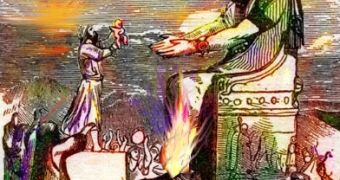1. The Israelite shepherd tribes wandered for centuries through the steppes and deserts of the Middle East until they left the nomad life for an agricultural one when, under the leadership of a man called Joshua, they established into Canaan (the Promised Land). But this happened only after chasing away the initial inhabitants of the country, the Canaanites, which had built walled cities. The Bible relates about this campaign.
2. Archaeological remains revealed both peaceful cohabitation between Israelites and Canaanites but also marks of violent encounters. In time, Canaanites were assimilated culturally and lost their idolatry and the faith in the god Baal. By the 10th century, Palestine was one of the most densely populated countries of the Middle East. Agriculture was practiced based on the water captured on rock caved wells and cisterns collecting the low winter rainfall. The size of each city or village was determined by how much water it could store.
3. The square adobe-made white houses had few windows, that protect their dwellers of the heating sun. The roofs were terraced, so that people could gather there to chat after the sunset. Cypresses, grape vines and fig trees were cultivated for shadows in the courtyards.
4. The patriarchal Israelite tribes were united by their faith in the unique and truthful god, Yahweh. The tribes were ruled initially by judges. Later, they were unified by the rule of one king, the most illustrious being David and Solomon. The Hebrew life was controlled by a precise moral code, the Decalog (Ten Commandments), delivered by God to Moises in Mount Sinai. Its principles and juridic norms organizing the people's life were extended into the Alliance Book, composed by judges for applying the mosaic law. The seven arm candelabra turned into a crucial cult element when Jews returned from their exile to Babylonia (forced by Assyrians). The 7 pointed star turned into the emblem of the Israelite community from that moment.
5. The patriarchal organization of the Hebrews meant the husband was the absolute chief in the house, and only men could lead the tribe or turn into judge. The matrimony could be dissolved if the husband repudiated his wife, sending her a divorce act.
6. Before the emergence of a kingdom, there was no professional Hebrew army. Later, the Hebrew soldiers wore helmets, spears, shields and swords. Fortresses were built in strategic places, on the coasts or possible invasion routes.
7. Canaanites posed many problems for the ancient Hebrews. They employed iron weapons (like swords) and war chariots. Philistians, believed to have been Indo-European (Canaanites were Semites, like the Jews), dominated the coastal land of Gaza since the 12th century BC from which they made many inland incursions. The name Palestine comes from that of this nation. Their religion was influenced by that of the Canaanites, and had the most formidable weaponry of the epoch (Goliath, the Philistian, wore a heavy armor). In time, the Jews copied the military techniques of the Canaanites and Philistians, but this did not impede the various foreign dominations, like the Assyrians, Persians, Greeks, Romans and others.
8. The Hebrew society was well structured in landowners (nobles), farmers, shepherds and craftsmen. Wine, raisins, olive oil and sheep wool were fundamental for the trade. Wine also had a religious role. Hebrews may have known also how to get royal purple from the Murex sea snails and wool was colored in large stone bathtubs.

 14 DAY TRIAL //
14 DAY TRIAL //